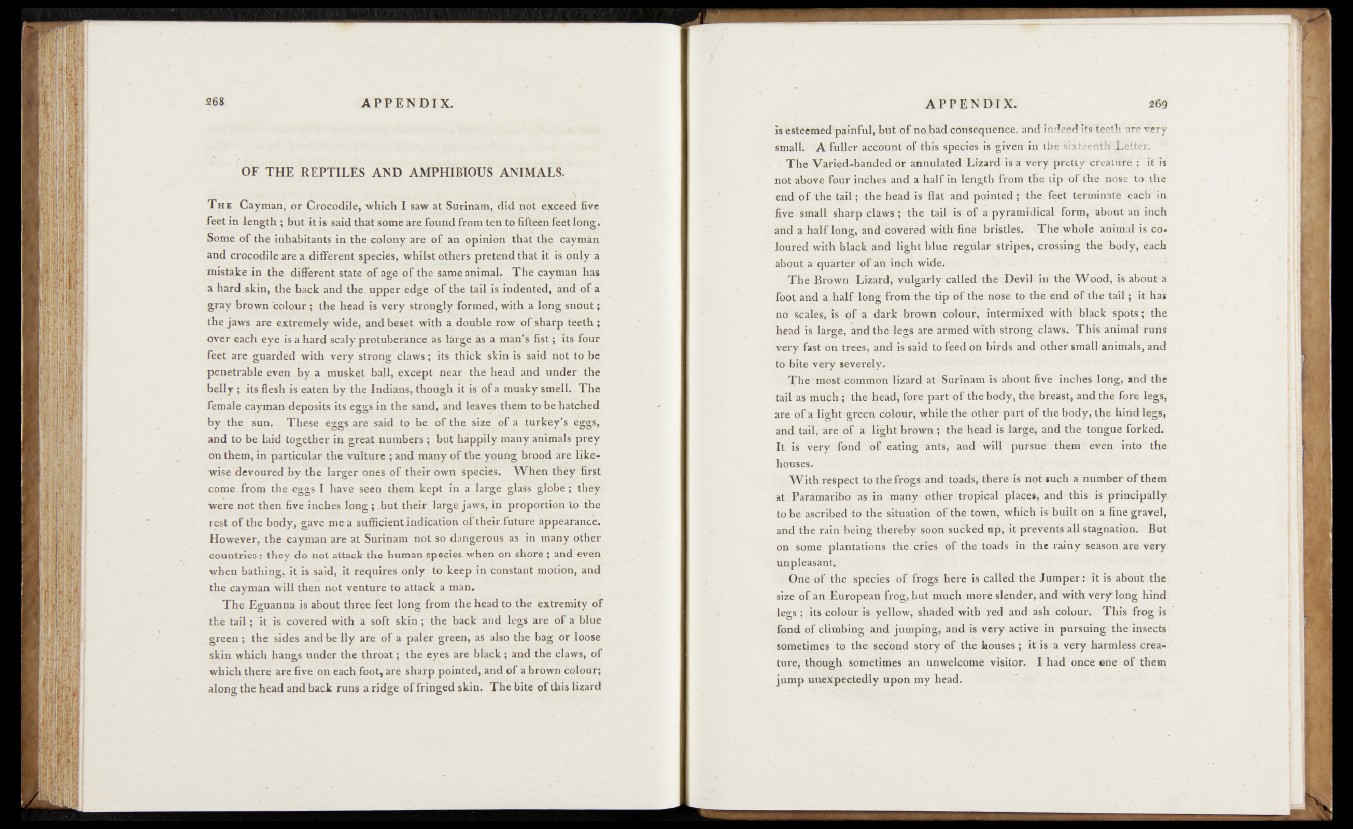
OF THE REPTILËS AND AMPHIBIOUS ANIMALS.
T he Cayman, or Crocodile, which I saw at Surinam, did not exceed five
feet in length; hut it is said that some are found from ten to fifteen feet long.
Some o f the inhabitants in the colony are of an opinion that the cayman
and crocodile are a different species, whilst others pretend that it is only a
mistake in the different state of age o f tjhe same animal.. The cayman has
a hard skin, the back and the upper edge o f the tail is indented, and of a
gray brown colour ; the head is very strongly formed, with a long snout;
the jaws are extremely wideband beset with a double row of sharp teeth ;
over each eye is a hard scaly protuberance as large as a man’s fist; its four
feet'are guarded with very strong claws; its.thick rkin is said not*tö be
penetrable even by a musket ball, except near the head and under the
b e lly ; its flesh is eaten by the Indians, though it is of a musky smell. -The
female cayman-deposits its eggs in the sand, and leaves them to-be hatched,
by the sun. These eggs are said to be o f the size of a turkey’s-eggs,
and to be laid together in great numbers ; but happily many animals prey
oh them, in particular the vulture ; and many of the young brood are likewise
devoured by the larger ones o f their own species. WBen they first
come from the. eggs l have seen them kept in a large glass globe ; they
were not then five inches.iong ; ,but their'large jaws, in proportion to the
rest o f the body, gave me a. sufficient indication of their future appearance.
However, the cayman are at Surinam not so'dangerous as\m many other
countries : they do not attack the human species when on shore ; and even
when bathing, it is .said, it requires only to keep in constant motion, and
the cayman will then not venture to attack a man.
The Eguanria is about three feet long from the head to the extremity óf
the tail; it is covered with a soft sk in ; the back and legs are of a blue
green ; the sides and be lly are o f a paler green, as also the bag or loose
skin which hangs under the throat'; the eyes are black; and the claws, of
which there are five on each foot, are sharp pointed, arid of a brown cölour;
along thé head and back runs a ridge of fringed skin. The bite of this lizard
is esteemed painful, but of no bad coriSequence, and indeed its teeth are very
smalll: A fuller acCoünt of this species is giveri iri the sixteenth Letter.
The Vartçd-banded Or annulated Lizard is a very pretty creature ; it is
not above four inches and a half in length from the tip of the nose to the
end o f the tail ; the head is flat. and pointed ; the, feet terminate each in
five small sharp claws ; the tail is of a pyramidiçal form, about ari I rich
and .a half long, and covered with fine bristles. The whole animal is Coloured
with black and light blue regular stripes, crossing the body, each
about a quarter ofian'inch wide.-
The Brown Lizard, vulgarly called the Devil in the Wood, is about a
foot and a half long from the tip of tfiri ri&se to the-end of the!tail*; it has
no scales, is' of a dark brown colour, intermixed with’ black spots ; the
head is large, and the legs are armed with strbng claws. This animal runs
very fast Ori trees, and is said to feed bn birds and other small animals, and
to bite vfery severely, i
The most Common lizard at Suririàm is about five inches long, and the
fail as much ; the head, fore part of the body, the breast, and the fore legs,
are of a light green colour, while the other part of the body, the hind legs,
and tail, are> of a light brown ; the head is large, and the tongue forked.
It is. very. fond o f eating ant's, aud will pursue them even into the
houses. 1 ;; ;? .,?■ 'V
; With respect to the frogs and toads, there is not such a number o f them
at Paramaribo as in many other tropical places, and- this* is principally
to be ascribed tb the situation of thé town, which-is built on a fine gravel,
and the rain- being thereby soon sucked up, it prevents all stagnation. But
on some plantations the cries of the toads in the rainy season are very
unpleasant.
Onfe of the species of frogs here is called the Jumper: it i f about the
size of an. European frog, but much: more slerider, and with v e r f long hind
legs ; its colour iâ' yellow, shaded with jed and ash colour. This frog is
fond of climbing and jumping, and is very active in pursuing the insects
sometimes to the second story of the houses; it is a very harmless creature,
though sometimes an uriwelcome visitor. I had once one of them
jump unexpectedly upon my head;